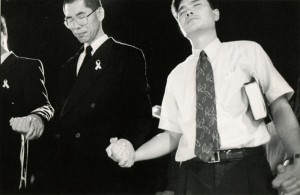by Jeff Fleischer
(Black Issues in Higher Education, August 5, 1999)
Photo by Arbutus
At the service, Reno, calling haters cowards who must be confronted until they back down, said, “People in this community came together to speak out against indifference. It was the right thing to do. This nation should follow your examples.”
In the wake of the shooting spree, both the Indiana University and Bloomington communities have vowed to remain vigilant against hate.
But even as thousands rallied against hatred, Bloomington experienced another apparently racially motivated attack the next day. A female African American student reported being stabbed in the abdomen while walking her dog. She described the assailant as a White man, wearing a ski mask and a swastika T-shirt.
The week before, IU campus police received two reports of men wearing swastikas threatening students. As of July 19, no suspects have been found.
Smith’s actions left two persons dead and nine injured over a three-day period. The spree started July 2 in Chicago, where the gunman opened fire on a group of Orthodox Jews, injuring six.
The next attack took place in Skokie, Ill., where former Northwestern University basketball coach Ricky Byrdsong, an African American, was shot and killed as he walked with his two children. Shortly thereafter, the gunman shot at two Asian Americans in nearby Northbrook, but they were not hurt.
Byrdsong, 43, became Northwestern’s coach in 1993 and led his team to a berth in the National Invitational Tournament, only the second post-season appearance in team history. He was fired in 1997 after compiling a 34-78 record.
“I hope he’s remembered for the one simple pure thing that he was, and that is that he was a flat-out good man,” Northwestern Athletic Director Rick Taylor said of Byrdsong.
All the shootings were drive-bys, and Smith’s car was identified at each crime scene.
The spree continued Saturday, as Smith injured an African American man in Springfield, Ill., wounded an African American minister in Decatur, Ill., and fired at six Asian American students near the University of Illinois.
Then on Sunday morning, Smith came to Bloomington, where he shot Yoon outside the Korean United Methodist Church.
Police matched Smith’s license plate number to the car identified in the previous shootings. Late Sunday night, Smith hijacked a van in Ina, Ill., then shot himself in nearby Salem after a police chase.
At Yoon’s service, Benjamin Johnson, a Justice Department representative who accompanied Reno, read a letter on behalf of President Bill Clinton that said: “The more we appreciate the others’ diversity, the more we appreciate the values we have in common. Diversity is one of our nation’s greatest strengths.”
Yoon, 26, left his family in Korea to attend college. He received both his bachelor’s and master’s degrees at Southern Illinois University. Yoon then came to IU to study aviation economics. He had been in town less than two months when he was killed. His parents came to Bloomington when they heard about his death.
“With his death, gone are the dreams, hopes and happiness my family has had with my son, Won Joon,” Shin Ho Yoon, the victim’s father, said at the service. “He was gunned down by one insane, full of racial hatred, young American man.”
“These actions must stop,” says IU’s president, Dr. Myles Brand. “Tolerance and respect for diversity must prevail.”
But soon after Smith’s suicide, two of 244 students in IU’s summer Groups. program say they were threatened by individuals with shaved heads who wore swastikas on their clothing.
“It’s very interesting [that] the students threatened are White,” says Janice Wiggins, the program’s director. “One was called ‘[n-word] lover’ because she was walking with Black kids and they told her that they didn’t want to see her on the street anymore.”
The previous day, a female Groups student reported two White males wearing red swastikas followed her up to the dorm, says Lt. Jerry Minger of the campus police department. When she heard footsteps and turned to look, the individuals stared at her, Minger says.
University officials met with the Groups students to try to alleviate fears. Dean of Students Richard McKaig described the students as concerned and anxious. Because of the incidents, he acknowledges, some students had decided to go home for the weekend. But McKaig says he is unaware of any students who left permanently.
IU police increased patrols and stationed officers at the dorm. Wiggins also says letters were sent to Groups students’ parents.
“We want to let them know the community as a whole is great,” Wiggins says. “We want to alleviate their fears and reassure them the campus and community really are committed to diversity and to having a safe and comfortable environment for the kids.”
IU and the Bloomington community have responded to the incidents with forums designed to find solutions to deal with the racial hatred. A discussion with campus leaders was held July 14, while a general town hall meeting took place July 19. Here, students and community members proposed ways to combat hate on campus.
McKaig says any IU policy changes have to wait until the faculty returns for fall session in late August. He says admissions policies, posting regulations, and hate speech codes would probably be reviewed by the Bloomington Faculty Council. But he also warned that the group must be careful not to impede First Amendment freedoms.
Jeff Fleischer is the editor in chief of the Indiana Daily Student.
Tags: benjamin smith, black issues in higher education, crime, indiana university, jeff fleischer, racism